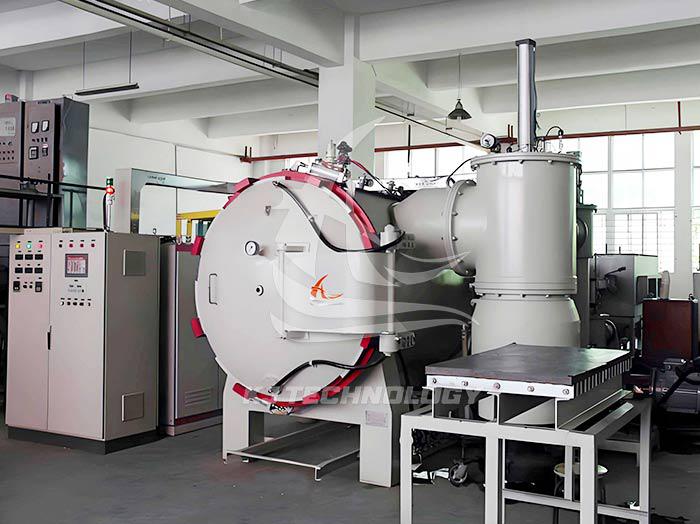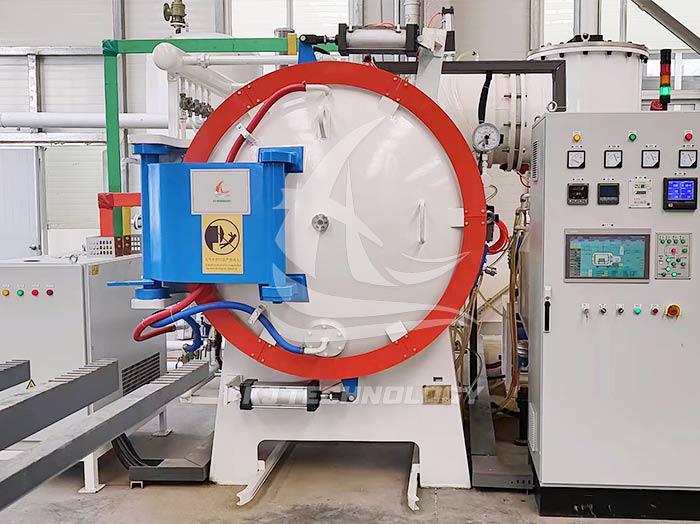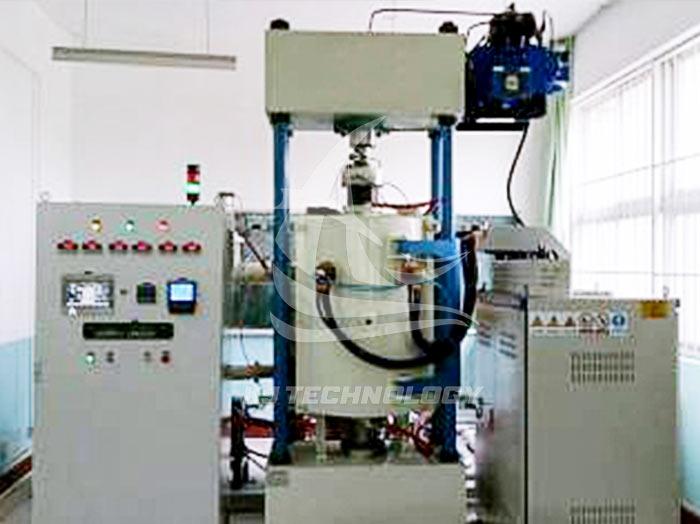Daily maintenance precautions for vacuum annealing muffle furnace
 05-15-2025 Author: KJ technology
05-15-2025 Author: KJ technology
The vacuum annealing muffle furnace, as a precision heat treatment equipment, plays an important role in industrial production. Daily maintenance is crucial to ensure its long-term stable operation, extend its service life, and ensure product quality. The following are the precautions for daily maintenance of vacuum annealing muffle furnace:
1. Electrical system maintenance
Regularly check electrical connections
Tightening connection: Check the electrical connection wires between the furnace body and the control cabinet once a week, including power lines, signal lines, etc., to check for any looseness, detachment, or damage. For example, if the power cord connector is loose, it may cause poor contact, unstable power supply to the equipment, affect heating efficiency, and even damage electrical components.
Insulation testing: Use a megohmmeter to test the insulation performance of electrical circuits every month to ensure that the insulation resistance meets the equipment requirements (generally requiring an insulation resistance of not less than 1M Ω). Poor insulation may cause electrical leakage accidents, endangering the safety of operators.
Maintenance of control components
Cleaning and inspection: Clean the control components such as contactors, relays, and circuit breakers in the control cabinet every week to remove dust and debris. At the same time, check whether the contacts of these components are corroded or oxidized, and if so, promptly handle or replace them. Poor contact can cause equipment control failure and affect normal production.
Parameter calibration: Calibrate the parameters of key control components such as temperature controllers and pressure controllers every quarter to ensure that their control accuracy meets process requirements. For example, excessive temperature controller error may lead to inaccurate annealing temperature and affect product quality.
2. Vacuum system maintenance
Vacuum pump maintenance
Oil level inspection and replacement: Check the oil level of the vacuum pump daily to ensure that it is within the normal range. According to the frequency of equipment use and working environment, the vacuum pump oil should be replaced regularly, usually every 200-300 hours of operation. If the oil becomes black, thick, or contains impurities, it should be replaced in a timely manner to ensure the normal operation and pumping efficiency of the vacuum pump.
Heat dissipation and cleaning: Maintain good heat dissipation of the vacuum pump, regularly clean the dust and debris around the vacuum pump, and ensure smooth ventilation. At the same time, check whether the intake and exhaust ports of the vacuum pump are blocked, and if so, clean them in a timely manner.
Vacuum pipelines and valves
Sealing inspection: Check the sealing condition of the connections and valves of the vacuum pipeline every week to see if there is any air leakage. You can apply soapy water to the sealed area and observe if any bubbles are generated. If air leakage is found, the connecting parts should be tightened or the sealing parts should be replaced in a timely manner.
Valve operation: Properly operate various valves on the vacuum pipeline to avoid damage to the valves caused by excessive force or frequent opening and closing. Regularly conduct activity tests on valves to ensure their flexibility in opening and closing, and reliable sealing.
3. Maintenance of furnace body and heating elements
Furnace body cleaning
Internal cleaning: After each annealing operation is completed, wait for the furnace body to cool to room temperature and promptly clean the oxide scale, debris, etc. inside the furnace. You can use a vacuum cleaner or soft bristled brush for cleaning, avoiding the use of sharp tools to scratch the inner wall of the furnace and prevent damage to the lining.
External cleaning: Regularly clean the dust and oil stains on the outside of the furnace body to keep the appearance of the furnace body clean. This not only extends the service life of the equipment, but also prevents dust and oil from entering the interior of the equipment and affecting its performance.
Heating element inspection and replacement
Appearance inspection: Check the appearance of the heating element every week to see if there is any deformation, fracture, ablation, or other phenomena. For example, if the heating wire breaks, it will cause uneven heating and affect the annealing effect.
Performance testing: Measure the resistance value of the heating element every month, compare it with the initial value, and determine whether the performance of the heating element has decreased. If the resistance value changes significantly, it indicates that the heating element may have aged and needs to be replaced in a timely manner.
4. Cooling system maintenance
Cooling water inspection
Water quality and level: Ensure that the water quality of the cooling water meets the equipment requirements and avoid using water containing a large amount of impurities and minerals to prevent scaling in the cooling pipeline and affect the cooling effect. Check the water level of the cooling water tank every day, replenish the cooling water in a timely manner, and prevent equipment overheating and damage caused by low water level.
Water temperature monitoring: Install a water temperature sensor to monitor the temperature of the cooling water in real time. Generally, it is required that the inlet temperature of the cooling water should not exceed 30 ℃ and the outlet temperature should not exceed 50 ℃. If the water temperature is too high, the cooling system's heat dissipation should be checked, such as whether the cooling fan is running normally and whether the cooling tower is blocked.
Cooling pipeline maintenance
Leakage inspection: Check the cooling pipeline for leaks every week, with a focus on inspecting the pipeline connections and valve positions. If a leak is found, the seal should be tightened or replaced in a timely manner to prevent cooling water leakage from causing equipment short circuit or damage.
Cleaning and descaling: Regularly clean and descaling the cooling pipes according to the usage of cooling water. Generally, it is carried out every six months to one year, and specialized pipeline cleaning agents can be used for cleaning to ensure the smoothness and cooling effect of the cooling pipeline.
5. Maintenance of safety devices
Over temperature protection device
Functional testing: Conduct monthly functional testing on the over temperature protection device, simulate over temperature conditions, and check if the protection device can cut off power and stop heating in a timely manner. This is an important measure to ensure that the equipment will not be damaged or cause safety accidents due to overheating in abnormal situations.
Calibration and adjustment: If any deviation is found in the set value of the over temperature protection device during testing, it should be calibrated and adjusted in a timely manner to ensure its accurate and reliable operation.
Pressure protection device
Regular calibration: According to the requirements of the equipment manual, the pressure protection device should be calibrated regularly, usually every six months. Ensure that the pressure protection device can operate accurately within the set pressure range, protecting the safety of equipment and operators.
Inspection and maintenance: Check the appearance and connection parts of the pressure protection device weekly to see if there is any damage or looseness. At the same time, clean the dust and debris on the surface of the pressure sensor to ensure accurate measurement.
6. Recording and Training
Maintenance records
Establish a comprehensive equipment maintenance record file, detailing the time, content, and replaced parts of each maintenance. By recording, potential problems with equipment can be identified in a timely manner, providing a basis for equipment maintenance and upkeep, and also helping to evaluate the service life and operating costs of the equipment.
Operator training
Regularly train operators on equipment maintenance knowledge and skills to familiarize them with the structure, performance, and maintenance requirements of the equipment. Operators should strictly follow the operating procedures for operation and maintenance to avoid equipment damage caused by improper operation.
By implementing the above daily maintenance precautions, the normal operation of the vacuum annealing muffle furnace can be effectively ensured, the service life and production efficiency of the equipment can be improved, and the equipment failure rate and maintenance costs can be reduced.








